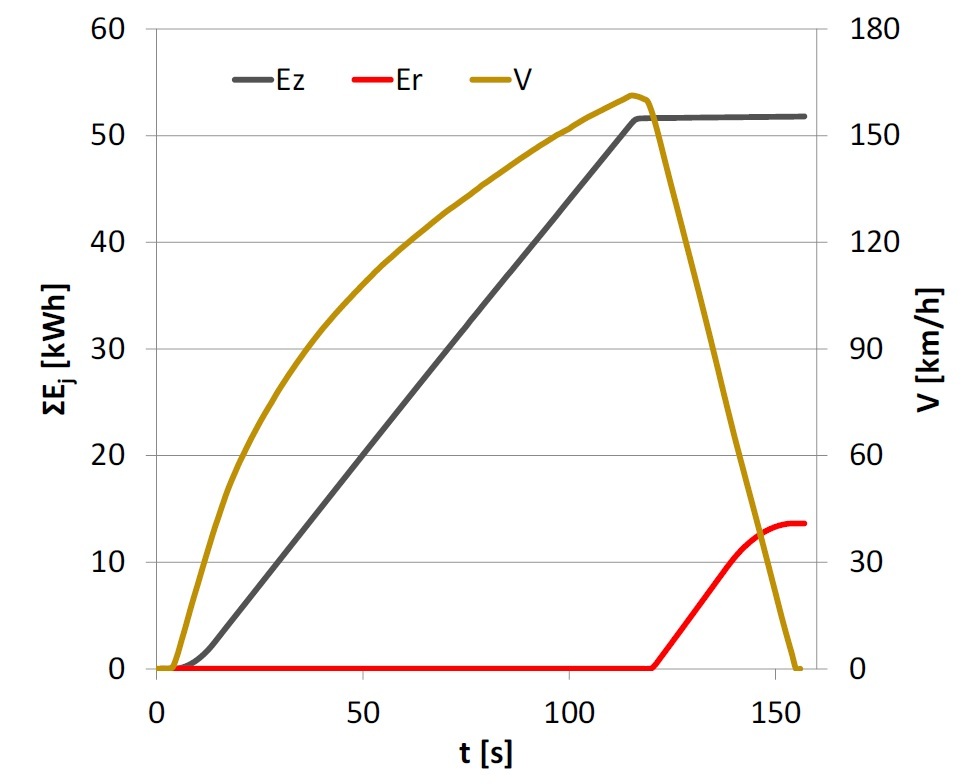PRACA ORYGINALNA
Integration of capacitors with carbon - lignin based electrodes in rail vehicles for enhanced energy efficiency
1
Poznan University of Technology, Faculty of Civil and Transport Engineering, Polska
2
Łukasiewicz Research Network – Poznan Institute of Technology, Center of Rail Vehicles, Polska
3
Poznan Univesity of Technology, Faculty of Civil and Transport Engineering, Polska
Data nadesłania: 03-11-2023
Data ostatniej rewizji: 27-11-2023
Data akceptacji: 30-11-2023
Data publikacji online: 02-12-2023
Data publikacji: 28-12-2023
Autor do korespondencji
Rail Vehicles/Pojazdy Szynowe 2023,3-4,33-39
SŁOWA KLUCZOWE
DZIEDZINY
STRESZCZENIE
The article presents considerations regarding the possibility of recovering braking energy of a rail vehicle. The energy parameters obtained during acceleration and braking of the loaded bus were taken as input data. It was found that over 13 kWh of energy was lost irretrievably in the braking resistors. Due to the speed of the discussed process, capacitors with an original design were proposed for energy recovery. For the purposes of this study, electrodes were fabricated using carbon derived from lignin carbonization at two distinct temperatures: 900°C and 1000°C. Based on the electrochemical tests carried out, it was found that the second proposed solution achieves a significantly better power-to-weight ratio – 13 kW/kg.
REFERENCJE (17)
1.
Endo M, Maeda T, Takeda T, Kim Y, Koshiba K, Hara H et al. Capacitance and pore-size distribution in aqueous and nonaqueous electrolytes using various activated carbon electrodes. J Electrochem Soc. 2001;148(8):A910. https://doi.org/10.1149/1.1382....
2.
European Commission. Regulation of the European Parliament and of the Council establishing the framework for achieving climate neutrality and amending Regulation (EU) 2018/1999 (European Climate Law). European Commission, 2020.
3.
Far M, Gallas D, Urbański P, Woch A, Mieżowiec K. Modern combustion-electric PowerPack drive system design solutions for a hybrid two-unit rail vehicle. Combustion Engines. 2022;190(3):80-87. https://doi.org/10.19206/CE-14....
4.
Kamińska M, Rymaniak Ł, Lijewski P, Szymlet N, Daszkiewicz P, Grzeszczyk R. Investigations of exhaust emissions from rail machinery during track maintenance operations. Energies. 2021;14(11):3141. https://doi.org/10.3390/en1411....
5.
Klapiszewski Ł, Szalaty TJ, Kurc B, Stanisz M, Zawadzki B, Skrzypczak A et al. Development of acidic imidazolium ionic liquids for activation of kraft lignin by controlled oxidation: comprehensive evaluation and practical utility. ChemPlusChem. 2018;83(5):361-374. https://doi.org/10.1002/cplu.2....
6.
Merkisz J, Lijewski P, Fuc P, Siedlecki M, Ziolkowski A. Development of the methodology of exhaust emis-sions measurement under RDE (Real Driving Emis-sions) conditions for non-road mobile machinery (NRMM) vehicles. IOP Conf Ser Mater Sci Eng. 2016;148:012077. https://doi.org/10.1088/1757-8....
7.
Pielecha I, Szwajca F. Two-and three-stage natural gas combustion system – experimental comparative analysis. Energies. 2023;16(9):3837. https://doi.org/10.3390/en1609....
8.
Pielecha J, Merkisz J. Opportunities to evaluate emission of particulate matter from the combustion engines of rail vehicles. Rail Vehicles/Pojazdy Szynowe. 2019;3:1-14. https://doi.org//10.53502/RAIL....
9.
Pielecha J, Skobiej K, Kurtyka K. Exhaust emissions and energy consumption analysis of conventional, hybrid, and electric vehicles in real driving cycles. Energies. 2020;13(23):6423. https://doi.org//10.3390/en132....
10.
Rymaniak Ł, Mąka M, Szymlet N, Kamińska M, Kęska A. Measurement of exhaust emissions from a two-wheeler – an experimental validation of the remote-sensing method. Journal of Ecological Engineering. 2023;24(12):.60-71. https://doi.org//10.12911/2299....
11.
Rymaniak Ł, Wiśniewski S, Woźniak K, Frankowski M. Evaluation of pollutant emissions from a railbus in real operating conditions during transport work. Combustion Engines. 2023;194(3):84-88. https://doi.org//10.19206/CE-1....
12.
Siedlecki M, Szymlet N, Fuć P, Kurc B. Analysis of the possibilities of reduction of exhaust emissions from a farm tractor by retrofitting exhaust aftertreatment. Energies. 2022;15(21):7963. https://doi.org/10.3390/en1521....
13.
Stobnicki P, Gallas D. Adoption of modern hydrogen technologies in rail transport. Journal of Ecological Engineering. 2022;23(3):84-91. https://doi.org/10.12911/22998....
14.
Szwajca F, Berger AW, Spalletta R, Pielecha I. Characteristics of fuel cells under static and dynamic conditions. Rail Vehicles/Pojazdy Szynowe. 2022;3-4:44-52. https://doi.org/10.53502/RAIL-....
15.
Urząd Transportu Kolejowego UT. Sprawozdanie z funkcjonowania rynku transportu kolejowego. 2022.
16.
Wendeker M, Gęca MJ, Grabowski Ł, Barański G. Measuring regenerative braking electricity generated by the city bus with internal combustion engine. Adv Sci and Tech. 2021;15(3):2115-223. https://doi.org/10.12913/22998....
17.
Zajt T. Metody woltamperometryczne i elektrochemiczna spektroskopia impedancyjna. Publishing House Gdansk University of Technology, Gdansk 2001.
Udostępnij
ARTYKUŁ POWIĄZANY
Przetwarzamy dane osobowe zbierane podczas odwiedzania serwisu. Realizacja funkcji pozyskiwania informacji o użytkownikach i ich zachowaniu odbywa się poprzez dobrowolnie wprowadzone w formularzach informacje oraz zapisywanie w urządzeniach końcowych plików cookies (tzw. ciasteczka). Dane, w tym pliki cookies, wykorzystywane są w celu realizacji usług, zapewnienia wygodnego korzystania ze strony oraz w celu monitorowania ruchu zgodnie z Polityką prywatności. Dane są także zbierane i przetwarzane przez narzędzie Google Analytics (więcej).
Możesz zmienić ustawienia cookies w swojej przeglądarce. Ograniczenie stosowania plików cookies w konfiguracji przeglądarki może wpłynąć na niektóre funkcjonalności dostępne na stronie.
Możesz zmienić ustawienia cookies w swojej przeglądarce. Ograniczenie stosowania plików cookies w konfiguracji przeglądarki może wpłynąć na niektóre funkcjonalności dostępne na stronie.



